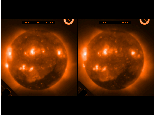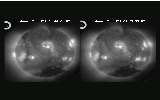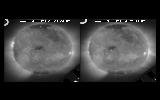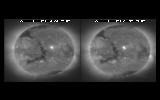
Quasi-stereoscopic Solar X-ray Image Pair
Greenbelt, MD 20771, USA
 |
Quasi-stereoscopic Solar X-ray Image Pair |
| NASA Goddard Space Flight Center Greenbelt, MD 20771, USA |

This pair of images, made by the S-054 X-ray Spectrographic Telescope on-board the US spacestation Skylab, shows the Sun's appearance in the combined X-ray wavebands 2-32 and 44-54Å. The bright material seen in the images is hot, rarefied gas of the Sun's outer atmosphere (the corona), glowing because of its high temperature of a million degrees Kelvin (or more). The forms of the gas clouds are determined by magnetic fields, which play a still mysterious role in heating the clouds to such high temperatures, and sometimes cause the clouds to explode, emitting intense bursts of harmful radiations throughout the solar system. The effects of the radiations on the terrestrial environment are subjects of great interest as likely factors in climate change and as hazards to astronauts and spacecraft. Forecasting of solar flares would be a great advance, and thus the dynamics of these clouds is of keen interest. The image pair represents a step towards better investigation of the physics of solar activity by obtaining more three-dimensional information about the coronal structures. In the time between the images (about 14 hours) the Sun's rotation provides a parallax via its rotation. The images have been registered and placed so that the viewer can train the left eye at the left image and right eye at the right image, obtaining a quasi- stereoscopic view, as if one had eyes separated by one tenth the distance from Earth to the Sun. Much of the Sun's coronal structure was stable during this time, so depth can be perceived. (To assist in viewing, the images are ideally sized as 6-cm squares, and a card may be placed vertically between the viewer's eyes to help train them towards the corresponding images.)

This pair of images, made by the S-054 X-ray Spectrographic Telescope on-board the US spacestation Skylab, shows the Sun's appearance in the combined X-ray wavebands 2-32 and 44-54Å. The bright material seen in the images is hot, rarefied gas of the Sun's outer atmosphere (the corona), glowing because of its high temperature of a million degrees Kelvin (or more). The forms of the gas clouds are determined by magnetic fields, which play a still mysterious role in heating the clouds to such high temperatures, and sometimes cause the clouds to explode, emitting intense bursts of harmful radiations throughout the solar system. The effects of the radiations on the terrestrial environment are subjects of great interest as likely factors in climate change and as hazards to astronauts and spacecraft. Forecasting of solar flares would be a great advance, and thus the dynamics of these clouds is of keen interest. The image pair represents a step towards better investigation of the physics of solar activity by obtaining more three-dimensional information about the coronal structures. In the time between the images (about 12.5 hours) the Sun's rotation provides a parallax via its rotation. The images have been registered and placed so that the viewer can train the left eye at the left image and right eye at the right image, obtaining a quasi- stereoscopic view, as if one had eyes separated by one tenth the distance from Earth to the Sun. Much of the Sun's coronal structure was stable during this time, so depth can be perceived. (To assist in viewing, the images are ideally sized as 6-cm squares, and a card may be placed vertically between the viewer's eyes to help train them towards the corresponding images.)

This pair of images, made by the S-054 X-ray Spectrographic Telescope on-board the US spacestation Skylab, shows the Sun's appearance in the combined X-ray wavebands 2-32 and 44-54Å. The bright material seen in the images is hot, rarefied gas of the Sun's outer atmosphere (the corona), glowing because of its high temperature of a million degrees Kelvin (or more). The forms of the gas clouds are determined by magnetic fields, which play a still mysterious role in heating the clouds to such high temperatures, and sometimes cause the clouds to explode, emitting intense bursts of harmful radiations throughout the solar system. The effects of the radiations on the terrestrial environment are subjects of great interest as likely factors in climate change and as hazards to astronauts and spacecraft. Forecasting of solar flare would be a great advance, and thus the dynamics of these clouds is of keen interest. The image pair represents a step towards better investigation of the physics of solar activity by obtaining more three-dimensional information about the coronal structures. In the time between the images (about 10.5 hours) the Sun's rotation provides a parallax via its rotation. The images have been registered and placed so that the viewer can train the left eye at the left image and right eye at the right image, obtaining a quasi- stereoscopic view, as if one had eyes separated by one tenth the distance from Earth to the Sun. Much of the Sun's coronal structure was stable during this time, so depth can be perceived. (To assist in viewing, the images are ideally sized as 6-cm squares, and a card may be placed vertically between the viewer's eyes to help train them towards the corresponding images.)

This pair of images, made by the S-054 X-ray Spectrographic Telescope on-board the US spacestation Skylab, shows the Sun's appearance in the combined X-ray wavebands 2-32 and 44-54Å. The bright material seen in the images is hot, rarefied gas of the Sun's outer atmosphere (the corona), glowing because of its high temperature of a million degrees Kelvin (or more). The forms of the gas clouds are determined by magnetic fields, which play a still mysterious role in heating the clouds to such high temperatures, and sometimes cause the clouds to explode, emitting intense bursts of harmful radiations throughout the solar system. The effects of the radiations on the terrestrial environment are subjects of great interest as likely factors in climate change and as hazards to astronauts and spacecraft. Forecasting of solar flares would be a great advance, and thus the dynamics of these clouds is of keen interest. The image pair represents a step towards better investigation of the physics of solar activity by obtaining more three-dimensional information about the coronal structures. In the time between the images (about 13 hours) the Sun's rotation provides a parallax via its rotation. The images have been registered and placed so that the viewer can train the left eye at the left image and right eye at the right image, obtaining a quasi- stereoscopic view, as if one had eyes separated by one tenth the distance from Earth to the Sun. Much of the Sun's coronal structure was stable during this time, so depth can be perceived. (To assist in viewing, the images are ideally sized as 6-cm squares, and a card may be placed vertically between the viewer's eyes to help train them towards the corresponding images.)
Additional solar images are available on the NSSDC Photo Gallery Solar page.
This information was originally provided by Dr. David A. Batchelor. Please acknowledge the Skylab X-ray telescope Principal Investigator A. Krieger for recording the original images, and Dr. David A. Batchelor for the image selection and graphics creation, if you make any public use of these data.